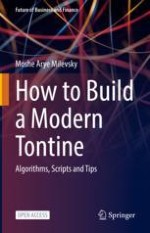Open Access 2022 | Open Access | Buch

How to Build a Modern Tontine
Algorithms, Scripts and Tips
verfasst von: Moshe Arye Milevsky
Verlag: Springer International Publishing
Buchreihe : Future of Business and Finance
Open Access 2022 | Open Access | Buch

verfasst von: Moshe Arye Milevsky
Verlag: Springer International Publishing
Buchreihe : Future of Business and Finance
This open access book introduces the modern tontine and its applications in retirement and decumulation. Personal financial management in the later stages of life presents unique challenges, and renowned retirement planning expert Dr. Milevsky proposes the modern tontine as a solution. With the goal of guiding professionals and retirees in more efficient decumulation, the book demonstrates how to build a modern tontine. It is technically oriented, employing a cookbook format, featuring R code, and examining retirement planning through a statistical lens. This how-to guide, which is a sequel to his 2020 book “Retirement Income Recipes in R”, will be invaluable for retirement planning professionals and advisors, as well as for PhD scholars in retirement planning, quantitative finance, and related fields.
This book is open access.